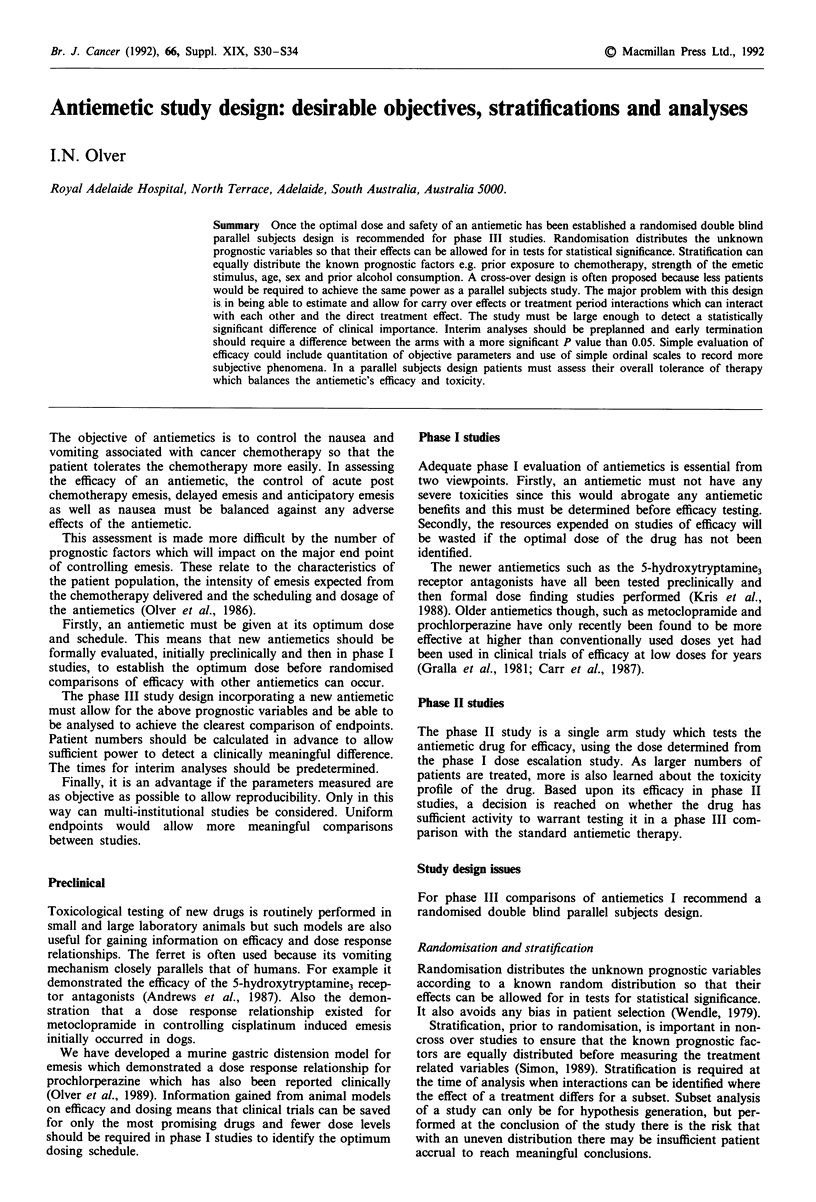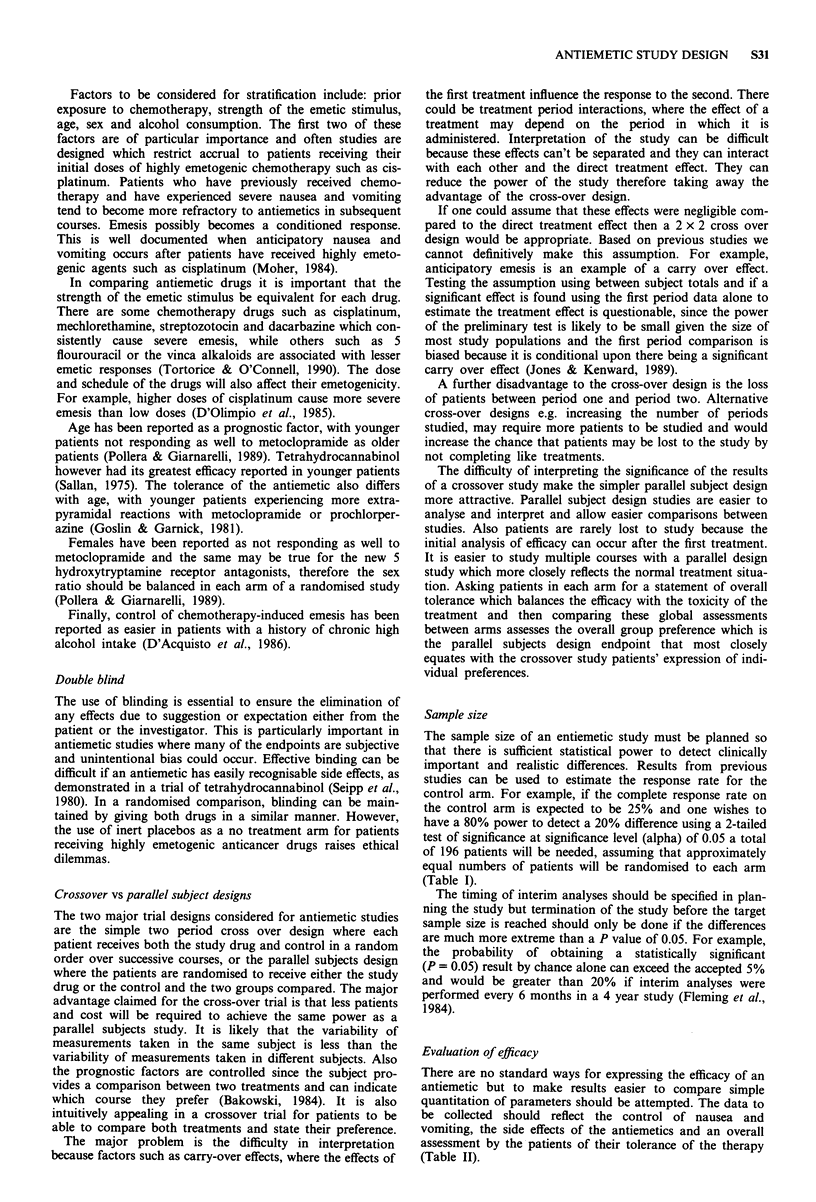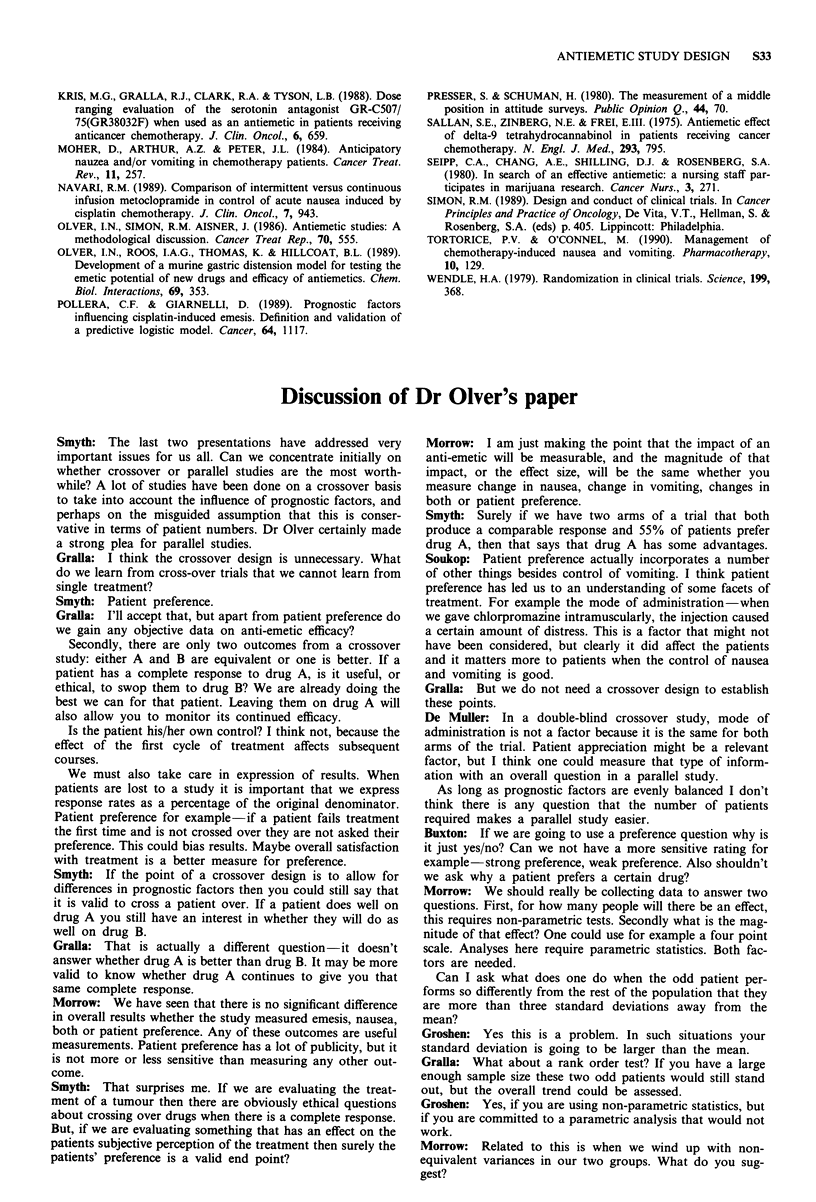Abstract
Once the optimal dose and safety of an antiemetic has been established a randomised double blind parallel subjects design is recommended for phase III studies. Randomisation distributes the unknown prognostic variables so that their effects can be allowed for in tests for statistical significance. Stratification can equally distribute the known prognostic factors e.g. prior exposure to chemotherapy, strength of the emetic stimulus, age, sex and prior alcohol consumption. A cross-over design is often proposed because less patients would be required to achieve the same power as a parallel subjects study. The major problem with this design is in being able to estimate and allow for carry over effects or treatment period interactions which can interact with each other and the direct treatment effect. The study must be large enough to detect a statistically significant difference of clinical importance. Interim analyses should be preplanned and early termination should require a difference between the arms with a more significant P value than 0.05. Simple evaluation of efficacy could include quantitation of objective parameters and use of simple ordinal scales to record more subjective phenomena. In a parallel subjects design patients must assess their overall tolerance of therapy which balances the antiemetic's efficacy and toxicity.
Full text
PDF



Selected References
These references are in PubMed. This may not be the complete list of references from this article.
- Bakowski M. T. Advances in anti-emetic therapy. Cancer Treat Rev. 1984 Sep;11(3):237–256. doi: 10.1016/0305-7372(84)90010-0. [DOI] [PubMed] [Google Scholar]
- Carr B. I., Blayney D. W., Goldberg D. A., Braly P., Metter G. E., Doroshow J. H. High doses of prochlorperazine for cisplatin-induced emesis. A prospective, random, dose-response study. Cancer. 1987 Nov 1;60(9):2165–2169. doi: 10.1002/1097-0142(19871101)60:9<2165::aid-cncr2820600908>3.0.co;2-c. [DOI] [PubMed] [Google Scholar]
- D'Olimpio J. T., Camacho F., Chandra P., Lesser M., Maldonado M., Wollner D., Wiernik P. H. Antiemetic efficacy of high-dose dexamethasone versus placebo in patients receiving cisplatin-based chemotherapy: a randomized double-blind controlled clinical trial. J Clin Oncol. 1985 Aug;3(8):1133–1135. doi: 10.1200/JCO.1985.3.8.1133. [DOI] [PubMed] [Google Scholar]
- Fetting J. H., Grochow L. B., Folstein M. F., Ettinger D. S., Colvin M. The course of nausea and vomiting after high-dose cyclophosphamide. Cancer Treat Rep. 1982 Jul;66(7):1487–1493. [PubMed] [Google Scholar]
- Fleming T. R., Green S. J., Harrington D. P. Considerations for monitoring and evaluating treatment effects in clinical trials. Control Clin Trials. 1984 Mar;5(1):55–66. doi: 10.1016/0197-2456(84)90150-8. [DOI] [PubMed] [Google Scholar]
- Gralla R. J., Itri L. M., Pisko S. E., Squillante A. E., Kelsen D. P., Braun D. W., Jr, Bordin L. A., Braun T. J., Young C. W. Antiemetic efficacy of high-dose metoclopramide: randomized trials with placebo and prochlorperazine in patients with chemotherapy-induced nausea and vomiting. N Engl J Med. 1981 Oct 15;305(16):905–909. doi: 10.1056/NEJM198110153051601. [DOI] [PubMed] [Google Scholar]
- Kris M. G., Gralla R. J., Clark R. A., Tyson L. B. Dose-ranging evaluation of the serotonin antagonist GR-C507/75 (GR38032F) when used as an antiemetic in patients receiving anticancer chemotherapy. J Clin Oncol. 1988 Apr;6(4):659–662. doi: 10.1200/JCO.1988.6.4.659. [DOI] [PubMed] [Google Scholar]
- Moher D., Arthur A. Z., Pater J. L. Anticipatory nausea and/or vomiting. Cancer Treat Rev. 1984 Sep;11(3):257–264. doi: 10.1016/0305-7372(84)90011-2. [DOI] [PubMed] [Google Scholar]
- Navari R. M. Comparison of intermittent versus continuous infusion metoclopramide in control of acute nausea induced by cisplatin chemotherapy. J Clin Oncol. 1989 Jul;7(7):943–946. doi: 10.1200/JCO.1989.7.7.943. [DOI] [PubMed] [Google Scholar]
- Olver I. N., Roos I. A., Thomas K., Hillcoat B. L. Development of a murine gastric distension model for testing the emetic potential of new drugs and efficacy of antiemetics. Chem Biol Interact. 1989;69(4):353–357. doi: 10.1016/0009-2797(89)90121-x. [DOI] [PubMed] [Google Scholar]
- Olver I. N., Simon R. M., Aisner J. Antiemetic studies: a methodological discussion. Cancer Treat Rep. 1986 May;70(5):555–563. [PubMed] [Google Scholar]
- Pollera C. F., Giannarelli D. Prognostic factors influencing cisplatin-induced emesis. Definition and validation of a predictive logistic model. Cancer. 1989 Sep 1;64(5):1117–1122. doi: 10.1002/1097-0142(19890901)64:5<1117::aid-cncr2820640525>3.0.co;2-r. [DOI] [PubMed] [Google Scholar]
- Sallan S. E., Zinberg N. E., Frei E., 3rd Antiemetic effect of delta-9-tetrahydrocannabinol in patients receiving cancer chemotherapy. N Engl J Med. 1975 Oct 16;293(16):795–797. doi: 10.1056/NEJM197510162931603. [DOI] [PubMed] [Google Scholar]
- Seipp C. A., Chang A. E., Shiling D. J., Rosenberg S. A. In search of an effective antiemetic: a nusring staff participates in marijuana research. Cancer Nurs. 1980 Aug;3(4):271–276. doi: 10.1097/00002820-198008000-00003. [DOI] [PubMed] [Google Scholar]
- Tortorice P. V., O'Connell M. B. Management of chemotherapy-induced nausea and vomiting. Pharmacotherapy. 1990;10(2):129–145. [PubMed] [Google Scholar]


